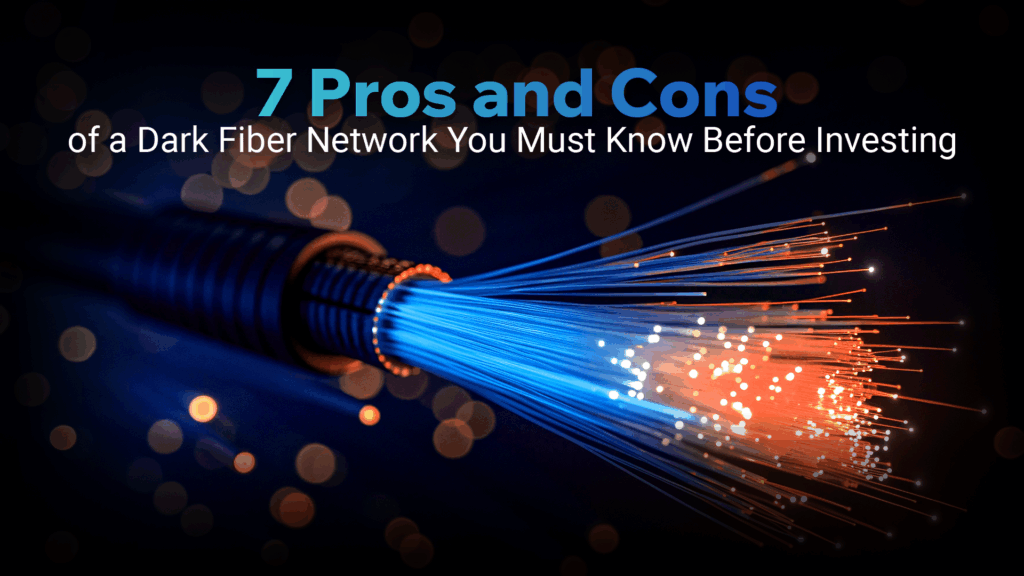
Dark fiber networks offer unparalleled control and scalability but come with the burden of high initial costs and full management responsibility. Understanding these trade-offs is crucial before investing.
Dark fiber refers to unused fiber-optic cable that has been laid but is not yet “lit” with optical signals or service provider equipment. Leasing or purchasing this unused infrastructure allows an organization to create its own private network.
7 Pros of a Dark Fiber Network
Investing in dark fiber provides critical advantages for organizations with high-bandwidth, low-latency, and stringent security requirements.
- Unlimited Scalability (Future-Proofing): The primary benefit. Capacity is virtually limitless and is only restricted by the equipment you place at each end of the fiber. As your bandwidth needs grow, you simply upgrade your optical transmission equipment (like DWDM or CWDM gear) instead of having to lay new cable or negotiate a higher-tier service plan.
- Complete Control & Customization: You become your own service provider. You have full control over the network’s architecture, protocols, security policies, and equipment choices. This allows for a highly customized network perfectly tailored to your business needs (e.g., specific latency settings, routing).
- Superior Security: Dark fiber offers the highest level of physical security and privacy. Since the fiber is dedicated solely to your organization, your data traffic is completely isolated from other users and public networks, significantly reducing the risk of external breaches or eavesdropping.
- Cost Efficiency (Long-Term): While the upfront investment is high, dark fiber often becomes more cost-effective than managed (lit) services over a long-term lease (10-20 years), especially for companies that require very high or rapidly growing bandwidth (e.g., 10 Gbps and up). Your monthly cost is a fixed lease fee, not a variable bandwidth charge.
- Extremely Low Latency: Dark fiber often provides the most direct, point-to-point connection between locations. This minimal path reduces network “hops,” resulting in the lowest possible latency, which is critical for real-time applications like high-frequency trading, cloud services, and real-time data center interconnects (DCI).
- Enhanced Reliability and Redundancy: You can design and implement your own network redundancy (e.g., leasing multiple geographically diverse fiber paths) and choose equipment with your desired Service Level Agreements (SLAs), offering superior resilience and greater uptime than what might be offered by a standard provider.
- Protocol and Equipment Flexibility: You’re not locked into a single provider’s technology stack. You can choose any protocol (Ethernet, Fibre Channel, SONET/SDH, etc.) and any vendor’s equipment, allowing you to use your existing hardware investments or adopt cutting-edge technology immediately.
7 Cons of a Dark Fiber Network
The freedom and capacity of dark fiber come with significant capital investment and operational responsibility.
- High Upfront Costs: This is the most significant barrier. The investment includes not only the dark fiber lease itself but also the purchase and installation of all necessary optical transmission equipment (transceivers, multiplexers, etc.) to “light” the fiber.
- Full Maintenance and Management Responsibility: You are responsible for everything that runs over the cable. This includes 24/7 monitoring, troubleshooting, repairing fiber cuts, replacing failed equipment, and all ongoing operational management. There is no ISP to call for a network outage.
- Required Technical Expertise: Managing a private optical network requires specialized, in-house technical staff with expertise in fiber optics, DWDM/CWDM, and networking protocols. Hiring or training this specialized team adds to your operational expenses.
- Geographic Availability Limitations: Dark fiber is only available where the underlying cable infrastructure has already been laid and has unused strands. If your desired route is in a rural area or lacks existing infrastructure, you may face expensive, time-consuming construction costs or find the service simply isn’t an option.
- Lack of Built-in Fault Tolerance (Initial): Unlike a managed service that often includes automatic failover and redundancy in its price, a basic dark fiber lease is just a point-to-point connection. To achieve high fault tolerance, you must lease a second, redundant path and invest in the switching equipment necessary to manage the failover, doubling the cost.
- Long-Term Contract Commitments: Dark fiber leases are typically long-term contracts, often spanning 10 to 20 years. This commitment means you are locked into a specific route and cost structure for a significant period, making it less flexible than shorter-term managed services if your location or needs change dramatically.
- Increased Power and Space Requirements: To “light” the fiber, you must install and power your own optical networking equipment (transceivers, amplifiers, etc.) at both endpoints. This requires dedicated rack space, cooling, and power in your data center or office locations.
| Feature | Dark Fiber | Managed (Lit) Fiber |
| Control | Full control over equipment, speed, and security | Limited; managed by the provider |
| Scalability | Virtually unlimited; upgrade equipment only | Limited to provider’s fixed service tiers |
| Cost Model | High upfront; lower long-term OpEx for high-bandwidth | Low upfront; higher recurring monthly cost |
| Responsibility | Customer (you) manages all equipment and maintenance | Provider manages all equipment and maintenance |
| Ideal For | Data centers, large enterprises, high-volume/low-latency needs | SMBs, standard corporate connectivity, moderate needs |
Ultimately, the decision to invest in dark fiber is a strategic one, balancing significant long-term advantages like total control and limitless scalability against the initial investment and maintenance commitment.
If your business is poised for rapid data growth and demands a private, high-performance foundation, exploring your specific options is the essential next step. To understand how dark fiber can be strategically mapped to your organization’s future, you can begin by looking into specialized providers and explore dark fiber solutions with network experts.
